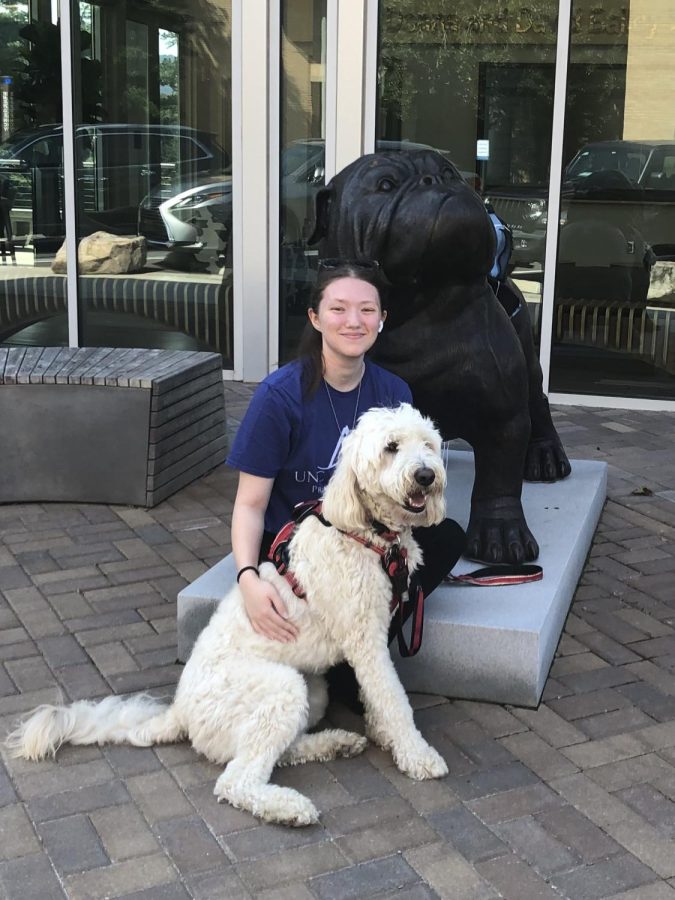UNCA accessibility office understaffed, according to student and faculty
Photo courtesy of Amanda Johnson.
UNCA Sophomore Amanda Johnson and her service dog Benson.
February 8, 2023
In the accessibility office of the University of North Carolina Asheville, one employee is responsible for assisting a student body of nearly 3,000 students who may need accommodations.
“As an able-bodied person, I do not have to think about how I am going to walk to class or how I am going to get into a restaurant. No one should have to fear not being able to go somewhere because it is not accessible,” said Morgan Glenn, a senior at the University of North Carolina Charlotte.
According to the National Center on Birth Defects and Developmental Disabilities, 1 in 4 adults in the United States has some type of disability.
Glenn has four years of experience working in health care as a CNA, assisting many different individuals with a variety of disabilities.
“I worked in a nursing home for two years and a hospital for a year. While working in these different facilities, I cared for many different people with different types of disabilities,” Glenn said last October.
At UNCA, the office of academic accessibility offers students with disabilities assistance and accommodations both in class and in residence halls.
“Right now in particular, every department is understaffed, but especially the accessibility department. Poor Meagan, they trained her for a month and were like ‘you’re the only employee, good luck,’” said Amanda Johnson, a sophomore at UNCA.
Meagan Sietsema is currently the only accessibility specialist available on campus.
“I don’t want to say it’s a lot to ask, because nothing is ever asking too much if it’s for accessibility, but there’s one employee and I feel really bad for her because there’s a lot of us,” Johnson said last October.
The number of active students registered with UNCA’s accessibility office is 494 students, according to their office of accessibility.
Johnson said the OAA should consider alternative accommodations before they tell students they are unattainable or unavailable to them.
The OAA does offer many assistive technologies that can be loaned to students for a semester.
“Students may use specific assistive devices on loan for a semester at a time, such as a smart pen that will record the audio from a lecture and pair it with the notes taken from the course,” Sistema said in October of last year.
Under the Individuals with Disabilities Education Act, education agencies must ensure students who have disabilities are offered the free, appropriate public education to which IDEA entitles them.
Sietsema said a student receives academic accommodations by submitting an application to the accessibility services at UNCA alongside documentation of their condition.
Undergraduate students with disabilities in both two and four-year institutions do not regularly inform their college of their disability, according to the NCES.
Johnson said she has a single-room accommodation in West Ridge, but was told to move dorms a few weeks before classes began. Johnson was able to stay due to the compromising solutions she offered.
Disabled students and students with accommodations do not receive priority access to housing on campus and are assigned to pick housing with all other students, according to the OAA at UNCA.
“I don’t know why it was so hard to come up with that. An 18-year-old had to do it. I’ve had to do that a few times, offering alternative suggestions as opposed to ‘no,’” Johnson said.
The Americans with Disabilities Act works to fight discrimination against disabled people as well as build a more accessible society by implementing strategies and requirements for many federal organizations such as the U.S. Department of Justice and Civil Rights Division.
“My older brother is in a power chair full time, so almost every time he goes somewhere he deals with accessibility issues,” Glenn said.
Although most buildings at UNCA incorporate universal design, some buildings lack accessible technology such as Phillips Hall, which does not have an elevator.
“Most entrances and exits have ramp access and automatic doors. The ones that don’t are being addressed as quickly as possible, but change anywhere takes time,” Siestsema said.
In the United States, the most common type of disability is mobility which affects 1 in 7 adults, becoming more common with age, according to the U.S. Department of Health and Human Services.
“On a mountainous campus, not all routes are accessible. Some are just too steep,” Sietsema said.
Mobillty issues affect a person’s ability to walk or use stairs; out of the 2 million disabled adults in North Carolina, 12% of them struggle with mobility, according to the Centers for Disease Control and Prevention.
“We have a work accessible path map which we share with students as requested, and we take note of any concerns brought to us,” Siestsema said.
Students who reported a disability were 10% more likely to use academic services when compared to their peers, according to the National Center for Education Statistics.
“The OAA is currently at half staff, so unfortunately I have very limited time,” Sietsema said.


![Brooke Pedersen [second from the right] and Luis Reyes [right] hold banners during the Wrap The Woods event.](https://thebluebanner.net/wp-content/uploads/2025/09/ELIZABETH_PRITCHITT_IMG_3470-1200x804.jpg)















